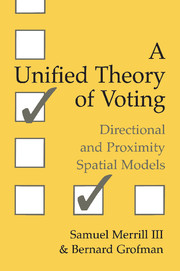Book contents
- Frontmatter
- Contents
- List of Tables and Figures
- Acknowledgments
- 1 Introduction
- Part I Models of Voter Behavior
- Part II Models of Party or Candidate Behavior and Strategy
- 8 Equilibrium Strategies for Two-Candidate Directional Spatial Models
- 9 Long-term Dynamics of Voter Choice and Party Strategy
- 10 Strategy and Equilibria in Multicandidate Elections
- 11 Strategy under Alternative Multicandidate Voting Procedures
- Postscript
- Appendices
- Glossary of Symbols
- References
- Index
11 - Strategy under Alternative Multicandidate Voting Procedures
Published online by Cambridge University Press: 04 December 2009
- Frontmatter
- Contents
- List of Tables and Figures
- Acknowledgments
- 1 Introduction
- Part I Models of Voter Behavior
- Part II Models of Party or Candidate Behavior and Strategy
- 8 Equilibrium Strategies for Two-Candidate Directional Spatial Models
- 9 Long-term Dynamics of Voter Choice and Party Strategy
- 10 Strategy and Equilibria in Multicandidate Elections
- 11 Strategy under Alternative Multicandidate Voting Procedures
- Postscript
- Appendices
- Glossary of Symbols
- References
- Index
Summary
[A] voter finds party ideologies useful because … ideologies help him focus attention on the differences between parties.
Anthony Downs, An Economic Theory of Democracy (1957: 98)Alternative Voting Procedures
Numerous voting procedures have been suggested for use in multicandidate elections, including the Borda count, the single-transferable vote (STV), plurality with runoff, and approval voting. That the choice of system can affect the outcome and the strategies of both voters and candidates and can advantage certain types of candidates – for example, centrists or extremists – has been well documented (Rae, 1971; Straffin, 1980; Riker, 1982; Bogdanor and Butler, 1983; Brams and Fishburn, 1983; Merrill, 1988; Cox, 1997). We discuss briefly – for directional and proximity assumptions – the regions of support and the strategies they imply for these alternative voting systems. This chapter is based on Merrill (1993).
Under approval voting, each voter casts a single vote each for as many candidates as he wishes. The candidate with the largest vote total wins. We assume that each voter chooses that strategy that will maximize his expected utility (see Merrill, 1988: 60). If the candidates are denoted by C1, … CK, the voter votes for Ci if his utility for Ci exceeds his average utility for all the candidates. For a two-dimensional RM model, each candidate receives votes from all voters in a half-plane bounded by a line that passes through the neutral point 0. Thus, for a symmetric voter distribution, each candidate receives support from exactly half the voters.
- Type
- Chapter
- Information
- A Unified Theory of VotingDirectional and Proximity Spatial Models, pp. 158 - 163Publisher: Cambridge University PressPrint publication year: 1999



